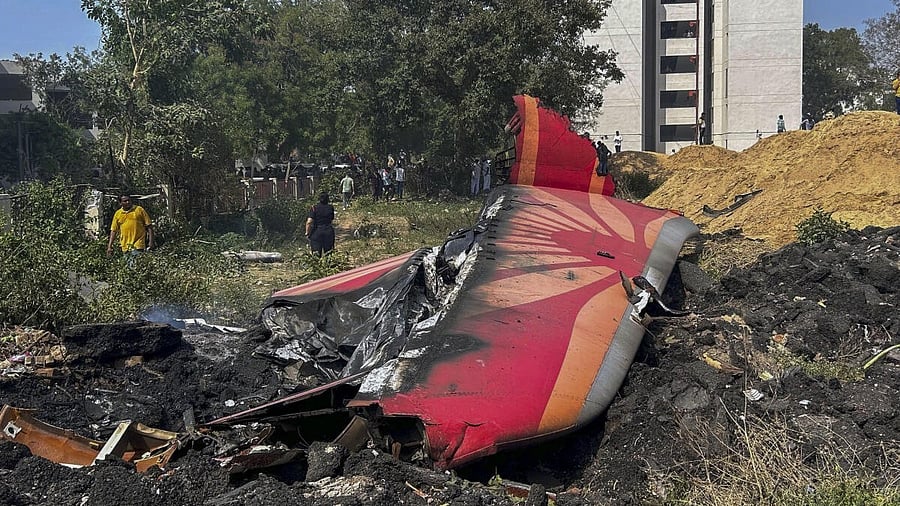
People near the debris of the Air India plane that crashed moments after taking off from the airport, in Ahmedabad.
Credit: PTI File Photo
The Aircraft Accident Investigation Bureau (AAIB) late Friday published its preliminary report on the fatal Air India plane crash that killed 260 people in Ahmedabad on June 12.
The report said that the fatal Air India crash showed the plane engines fuel cutoff switches shifting from cutoff to run within seconds of each other.
Releasing the report a month after the fatal crash, the AAIB said the aircraft air/ground sensors transitioned to air mode, consistent with liftoff at 08:08:39 UTC.
"The aircraft achieved the maximum recorded airspeed of 180 Knots IAS at about 08:08:42 UTC and immediately thereafter, the Engine 1 and Engine 2 fuel cutoff switches transitioned from RUN to CUTOFF position one after another with a time gap of 01 sec," the report said.
The reports also added that, "In the cockpit voice recording, one of the pilots is heard asking the other why did he cutoff. The other pilot responded that he did not do so."
Providing a sequence of the happenings, AAIB said the CCTV footage obtained from the airport showed Ram Air Turbine (RAT) getting deployed during the initial climb immediately after lift off.
"No significant bird activity is observed in the vicinity of the flight path. The aircraft started to lose altitude before crossing the airport perimeter wall," it said.
As per the EAFR, the engine 1 fuel cutoff switch transitioned from CUTOFF to RUN at about 08:08:52 UTC. Thereafter at 08:08:56 UTC, the engine 2 fuel cutoff switch also transitions from CUTOFF to RUN.
"When fuel control switches are moved from CUTOFF to RUN while the aircraft is inflight, each engines full authority dual engine control (FADEC) automatically manages a relight and thrust recovery sequence of ignition and fuel introduction," the report said.
"The EGT (Exhaust Gas Temperature) was observed to be rising for both engines indicating relight. engine 1's core deceleration stopped, reversed and started to progress to recovery. Engine 2 was able to relight but could not arrest core speed deceleration and re-introduced fuel repeatedly to increase core speed acceleration and recovery," the report said.
The EAFR recording stopped at 08:09:11 UTC (Coordinated Universal Time).
At about 08:09:05 UTC, one of the pilots transmitted 'MAYDAY MAYDAY MAYDAY' and when the Air Traffic Controller (ATCO) enquired about the call sign, there was no response but the ATCO observed the aircraft crashing outside the airport boundary and activated the emergency response.
"At 08:14:44 UTC, Crash Fire Tender left the airport premises for Rescue and firefighting. They were joined by Fire and Rescue services of local administration," the AAIB said.
In its 15-page report, AAIB said the wreckage site activities, including drone photography/videography have been completed and the wreckage has been moved to a secure area near the airport.
"Both engines were retrieved from the wreckage site and quarantined at a hangar in the airport," the report said.
"Components of interest for further examinations have been identified and quarantined," it said.
On June 12, Air India's Boeing 787-8 aircraft operating flight AI 171 en-route to London Gatwick crashed into a medical hostel complex soon after take-off from Ahmedabad, killing 260 people, including 241 persons who were onboard the plane. One passenger survived the crash.
It was also the first time that the best-selling wide-body Dreamliner or Boeing 787 suffered a fatal accident resulting in hull loss.
Investigation team will examine additional evidence that are being sought from stakeholders, the report sad. AAIB report also said that there are no recommended actions to Boeing 787-8 plane operators at this stage of probe.
On June 26, a status report of the crash was released by the civil aviation ministry.
With PTI inputs
